64 Cores of Rendering Madness: The AMD Threadripper Pro 3995WX Review
by Dr. Ian Cutress on February 9, 2021 9:00 AM EST- Posted in
- CPUs
- AMD
- Lenovo
- ThinkStation
- Threadripper Pro
- WRX80
- 3995WX
CPU Tests: Rendering
Rendering tests, compared to others, are often a little more simple to digest and automate. All the tests put out some sort of score or time, usually in an obtainable way that makes it fairly easy to extract. These tests are some of the most strenuous in our list, due to the highly threaded nature of rendering and ray-tracing, and can draw a lot of power. If a system is not properly configured to deal with the thermal requirements of the processor, the rendering benchmarks is where it would show most easily as the frequency drops over a sustained period of time. Most benchmarks in this case are re-run several times, and the key to this is having an appropriate idle/wait time between benchmarks to allow for temperatures to normalize from the last test.
Blender 2.83 LTS: Link
One of the popular tools for rendering is Blender, with it being a public open source project that anyone in the animation industry can get involved in. This extends to conferences, use in films and VR, with a dedicated Blender Institute, and everything you might expect from a professional software package (except perhaps a professional grade support package). With it being open-source, studios can customize it in as many ways as they need to get the results they require. It ends up being a big optimization target for both Intel and AMD in this regard.
For benchmarking purposes, we fell back to one rendering a frame from a detailed project. Most reviews, as we have done in the past, focus on one of the classic Blender renders, known as BMW_27. It can take anywhere from a few minutes to almost an hour on a regular system. However now that Blender has moved onto a Long Term Support model (LTS) with the latest 2.83 release, we decided to go for something different.
We use this scene, called PartyTug at 6AM by Ian Hubert, which is the official image of Blender 2.83. It is 44.3 MB in size, and uses some of the more modern compute properties of Blender. As it is more complex than the BMW scene, but uses different aspects of the compute model, time to process is roughly similar to before. We loop the scene for at least 10 minutes, taking the average time of the completions taken. Blender offers a command-line tool for batch commands, and we redirect the output into a text file.
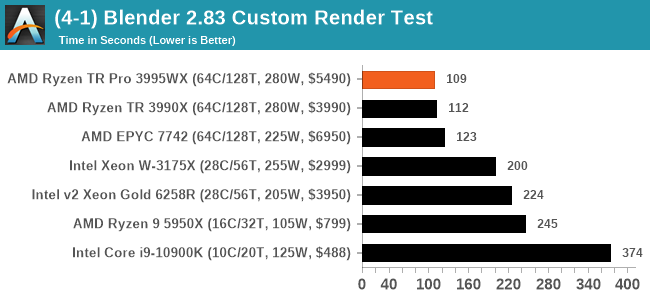
The first benchmark out of the gate and a win is scored by the TR Pro. It's only a small win at around 3%, but it showcases that the eight memory channels outweigh the extra frequency of regular Threadripper here.
Corona 1.3: Link
Corona is billed as a popular high-performance photorealistic rendering engine for 3ds Max, with development for Cinema 4D support as well. In order to promote the software, the developers produced a downloadable benchmark on the 1.3 version of the software, with a ray-traced scene involving a military vehicle and a lot of foliage. The software does multiple passes, calculating the scene, geometry, preconditioning and rendering, with performance measured in the time to finish the benchmark (the official metric used on their website) or in rays per second (the metric we use to offer a more linear scale).
The standard benchmark provided by Corona is interface driven: the scene is calculated and displayed in front of the user, with the ability to upload the result to their online database. We got in contact with the developers, who provided us with a non-interface version that allowed for command-line entry and retrieval of the results very easily. We loop around the benchmark five times, waiting 60 seconds between each, and taking an overall average. The time to run this benchmark can be around 10 minutes on a Core i9, up to over an hour on a quad-core 2014 AMD processor or dual-core Pentium.

Another small 3% win in Corona, and almost double what Intel is offering.
Crysis CPU-Only Gameplay
One of the most oft used memes in computer gaming is ‘Can It Run Crysis?’. The original 2007 game, built in the Crytek engine by Crytek, was heralded as a computationally complex title for the hardware at the time and several years after, suggesting that a user needed graphics hardware from the future in order to run it. Fast forward over a decade, and the game runs fairly easily on modern GPUs.
But can we also apply the same concept to pure CPU rendering? Can a CPU, on its own, render Crysis? Since 64 core processors entered the market, one can dream. So we built a benchmark to see whether the hardware can.
For this test, we’re running Crysis’ own GPU benchmark, but in CPU render mode. This is a 2000 frame test, with medium and low settings.
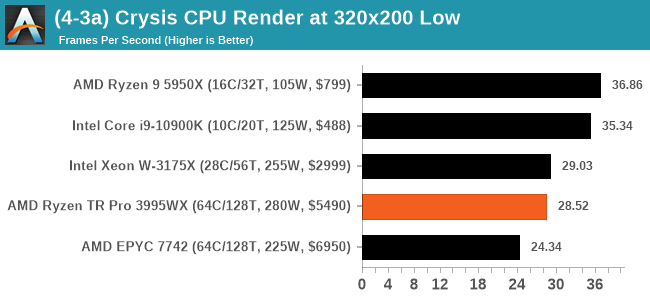
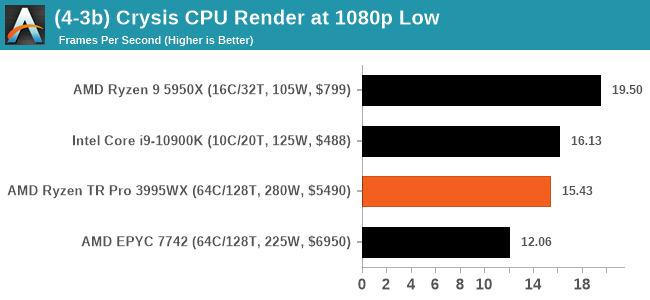
The Crytek engine used for Crysis has two key limitations: up to 32 threads, and up to 23 cores. As a result our high-end CPUs here are pegged to those cores, and single-thread limits come into play. The TR 3995WX has a healthy lead over the EPYC 7742, but loses out against the mainstream processors.
POV-Ray 3.7.1: Link
A long time benchmark staple, POV-Ray is another rendering program that is well known to load up every single thread in a system, regardless of cache and memory levels. After a long period of POV-Ray 3.7 being the latest official release, when AMD launched Ryzen the POV-Ray codebase suddenly saw a range of activity from both AMD and Intel, knowing that the software (with the built-in benchmark) would be an optimization tool for the hardware.
We had to stick a flag in the sand when it came to selecting the version that was fair to both AMD and Intel, and still relevant to end-users. Version 3.7.1 fixes a significant bug in the early 2017 code that was advised against in both Intel and AMD manuals regarding to write-after-read, leading to a nice performance boost.
The benchmark can take over 20 minutes on a slow system with few cores, or around a minute or two on a fast system, or seconds with a dual high-core count EPYC. Because POV-Ray draws a large amount of power and current, it is important to make sure the cooling is sufficient here and the system stays in its high-power state. Using a motherboard with a poor power-delivery and low airflow could create an issue that won’t be obvious in some CPU positioning if the power limit only causes a 100 MHz drop as it changes P-states.
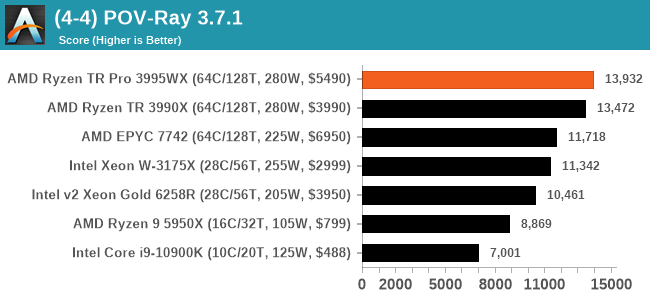
POV-Ray is another 3% win for the TR Pro 3995WX.
V-Ray: Link
We have a couple of renderers and ray tracers in our suite already, however V-Ray’s benchmark came through for a requested benchmark enough for us to roll it into our suite. Built by ChaosGroup, V-Ray is a 3D rendering package compatible with a number of popular commercial imaging applications, such as 3ds Max, Maya, Undreal, Cinema 4D, and Blender.
We run the standard standalone benchmark application, but in an automated fashion to pull out the result in the form of kilosamples/second. We run the test six times and take an average of the valid results.
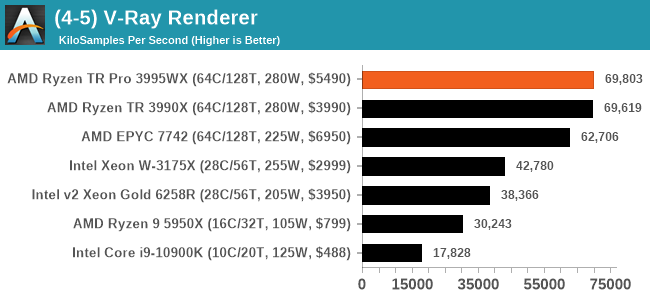
Less than 0.3% win here this time, but AMD's 64-core offerings are still ahead of the game.
Cinebench R20: Link
Another common stable of a benchmark suite is Cinebench. Based on Cinema4D, Cinebench is a purpose built benchmark machine that renders a scene with both single and multi-threaded options. The scene is identical in both cases. The R20 version means that it targets Cinema 4D R20, a slightly older version of the software which is currently on version R21. Cinebench R20 was launched given that the R15 version had been out a long time, and despite the difference between the benchmark and the latest version of the software on which it is based, Cinebench results are often quoted a lot in marketing materials.
Results for Cinebench R20 are not comparable to R15 or older, because both the scene being used is different, but also the updates in the code bath. The results are output as a score from the software, which is directly proportional to the time taken. Using the benchmark flags for single CPU and multi-CPU workloads, we run the software from the command line which opens the test, runs it, and dumps the result into the console which is redirected to a text file. The test is repeated for a minimum of 10 minutes for both ST and MT, and then the runs averaged.
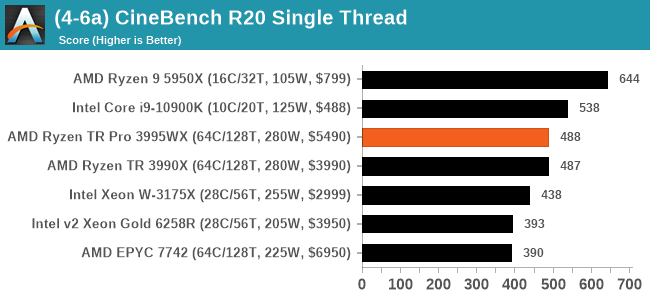
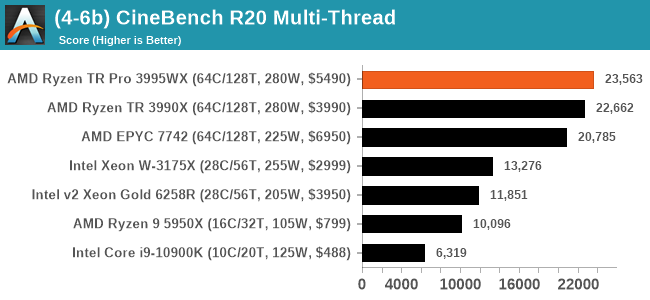
Cinebench ST scores are clearly in the realm of the mainstream processors, but when firing up all the threads, the TR Pro 3995WX takes a 4% lead over the standard 3990X, and scores 2.33x more than the mainstream 16-core Ryzen 9.
















118 Comments
View All Comments
brucethemoose - Tuesday, February 9, 2021 - link
There are large efforts in various communities, from Rust and C++ to Linux distros and game engines, to improve autovectorization.This means that more software should support AVXwhatever with minimal or no support from devs as time goes on.
Also, one can"t always just "go to the GPU." Video encoding is a great example where this won't work.
RSAUser - Wednesday, February 10, 2021 - link
NVENC seems to work pretty well.eastcoast_pete - Wednesday, February 10, 2021 - link
The newest generation of NVENC (since Turing) is indeed quite capable at encoding and transcoding to AVC and h265. That ASIC has come a long way, and is really fast. However, for customized encoding situations, the story shifts; that's where CPU-based encoding comes into its own. Also, if you want AV1 encoding, we're still OOL on GPUs; if that has changed, I'd love to know. Lastly, a lot of the work these workstations are used for is CGI and editing, and for those, a combination of lots of RAM, many-core CPUs like these here and 1-2 higher end GPUs is generally what people use who do this for a living.GeoffreyA - Friday, February 12, 2021 - link
NVENC, VCE, etc., work brilliantly when it comes to speed, but if one is aiming for best quality or size, it's best to go for software encoding. x264 does support a bit of OpenCL acceleration but there's hardly any gain, and it's not enabled by default. Also, even when AV1 ASICs are added, I've got a feeling it'll fall well below software encoding.phoenix_rizzen - Tuesday, February 9, 2021 - link
More like, unless you absolutely NEED AVX-512 support, there's absolutely no reason to use an Intel setup.Pick a Ryzen, Threadripper, or EPYC depending on your needs, they'll all be a better value/performer than anything Intel currently has on the market.
twtech - Tuesday, February 9, 2021 - link
It's workload-dependent, and what you're looking for. While regular TR supports ECC, it doesn't support registered ECC, which is 99% of ECC memory. The 8 memory channels also make a big difference in some workloads, such as compiling code. Also the TR Pro has a lot more PCIE lanes, as well as better support for business/corporate management.So I agree with your statement if you are a solo operator with a workload that is not only not very memory dependent, but not very memory-bandwidth dependent either.
eastcoast_pete - Wednesday, February 10, 2021 - link
For the use case covered here (customized CPU rendering), those many cores are hard to beat. In that scenario, the main competitors for the TR pros are the upcoming, Zen 3-based Epyc and non-pro TRs. Unfortunately, Intel is still way behind. What I wonder about also is whether some of these rendering suites are also available for ARM's Neoverse arch; some of those 128+ core CPUs might be quite competitive, if the software exists.wumpus - Wednesday, February 10, 2021 - link
I'm guessing that a lot of the times that feature will be ECC. How many tasks worth doing on a 5-figure workstation are worth having botched bytes thanks to a memory error?Granted, a lot of the times that ECC is needed are also going to be the >256GB cases, but ECC is pretty important (if only to known that there *wasn't* a memory error).
The Hardcard - Tuesday, February 9, 2021 - link
While the EPYC name is epic, it doesn’t scream “for heavyweight computational workloads” like Threadripper does. Both names are candidates for bonuses, but whoever thought up Threadriipper should get the bigger one.If the same person is responsible for both names, then the title AMD Marketing Fellow was earned.
Oxford Guy - Tuesday, February 9, 2021 - link
Threadripper is even more corny than EPYC. Neither inspire much confidence from a professional standpoint, sounding like gamer speak.